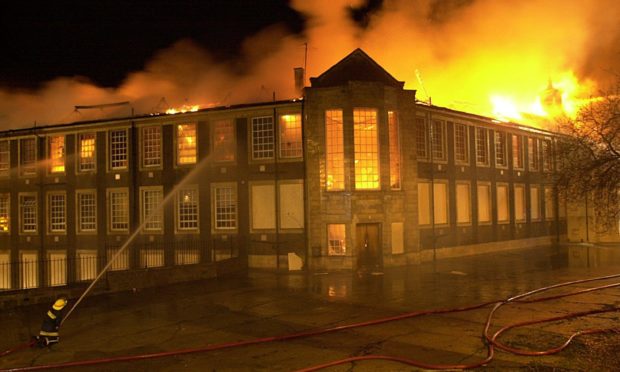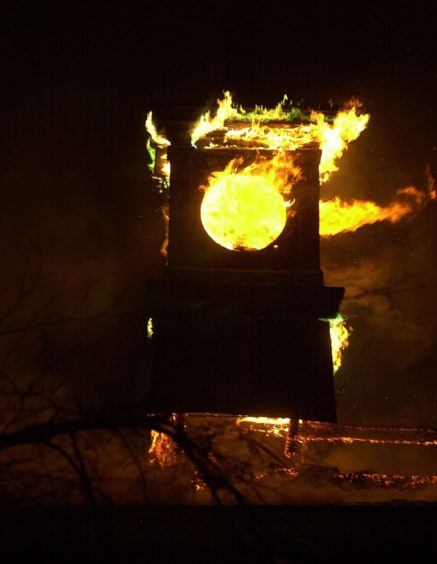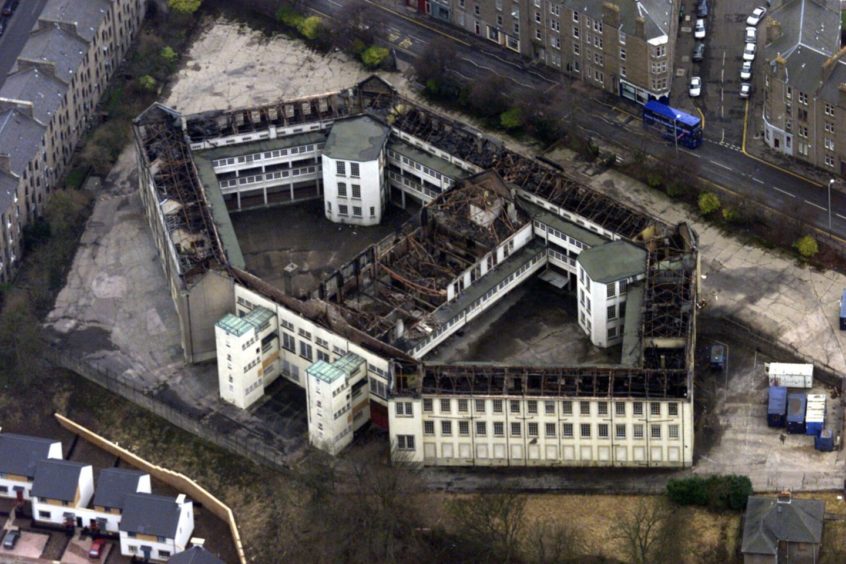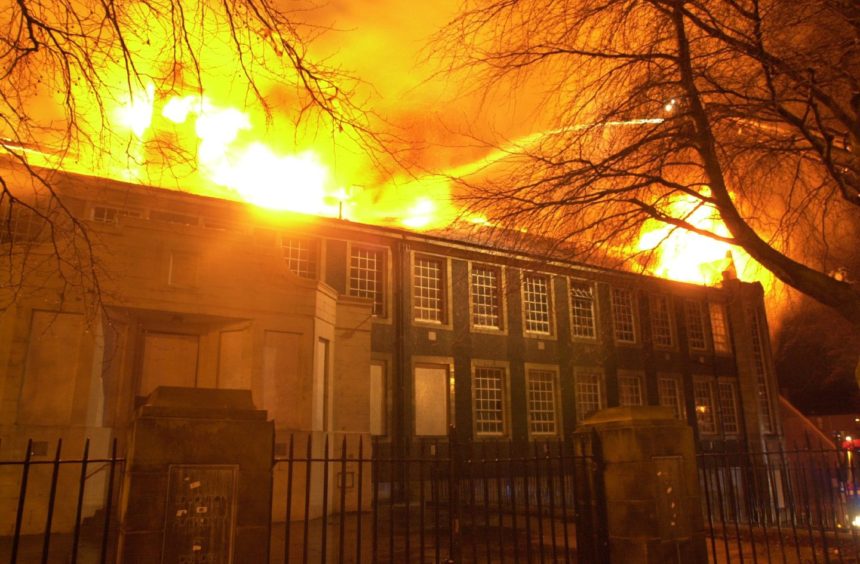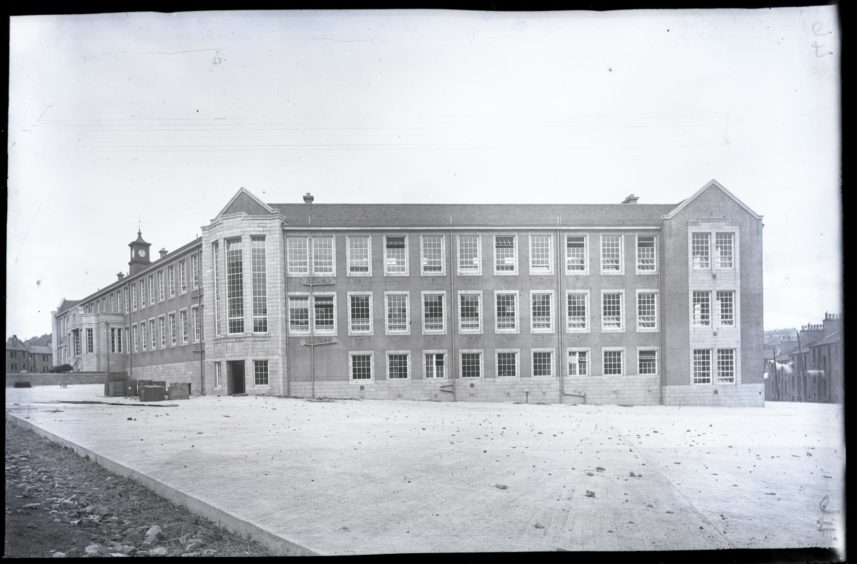Time stood still as the former Logie School in Dundee was engulfed by flames 20 years ago.
The 100-foot high flames spread rapidly throughout the B-listed building and could be seen from as far afield as Wormit and Broughty Ferry.
Within 30 minutes of the fire being discovered at 9pm, around 50% of the roof was ablaze.
Hundreds of people gathered in the street as 60 firefighters fought a losing battle to contain the flames which spread rapidly in all directions.
At 11pm a poignant reminder of the historical significance of the school, the clock tower with the hands showing the time at 8 o’clock, disappeared into the centre of the flames, signalling that the last remaining part of the roof had collapsed.
A school history lesson
Logie Central School was opened in 1929 on the site of the former West Poor House and initially took secondary pupils for only three years before becoming a fourth year selective school until 1974.
The school was known by pupils as The Penitentiary after its unique hexagonal design and later acted as an annexe to Harris Academy before being closed in 1998.
Since then the building had been boarded up and preliminary investigations suggested the fire was started deliberately in the upper reaches of the building.
Evidence of forced entry to the building was detected and a group of youths were seen running away from the scene before the blaze took hold.
The fire would be overshadowed just a week later when Morgan Academy was virtually destroyed when a spectacular blaze ripped through the 133-year building.
On January 21, 2002, a boy, then aged 14, appeared before a sheriff and admitted starting the fire at the former Logie School which had been closed since 1998.
The sheriff remitted the boy to the Children’s Panel.
The council had to pay £126,000 to demolish the building and only £30,000 was covered by insurance.
In addition, one of the reasons given for an above-inflation rise in council house rents in 2002 was the increased cost for fire insurance due to the blazes at Logie and Morgan.
Sad final chapter for the school
The demolition marked a sad end to a school which was opened with a gold key by then Scottish Secretary of State, William Adamson, who was a former Fife coal miner.
Mr Adamson said he left school at 11 to work in the mines – not because his mother lacked interest in her boy’s education, but from economic necessity.
In 1885 as many as 4,500 children in Dundee factories attended school as ‘half-timers’ (they attended school for half the week and worked the rest in the factory) before the exemption regulations were changed by the School Board.
Almost all children in 1929 were now remaining in education until they were 14 and half-timers, half-time schools and adventure schools were a thing of the past.
Mr Adamson congratulated the people of Dundee and said the city had done very well in recent years in improving its housing.
He said the new housing was a joy to behold and every day the housing of the city was becoming more worthy of its beautiful natural situation.
The new homes were necessary to address its dreadful housing, described by the 1917 Royal Commission as ‘32,000 living in overcrowded conditions in Dundee’.
The end of the First World War in 1918 created a huge demand for working class housing in towns throughout Britain.
The 1919 Act – often known as the Addison Act after its author, Dr Christopher Addison, the Minister of Health – made housing a national responsibility.
Local authorities were given the task of developing new housing and rented accommodation where it was needed by working people.
Logie estate’s four-flat blocks, designed by renowned city architect James Thomson and centred on a tree-lined avenue, became Scotland’s first council housing scheme and the first estate in Europe to have a district heating system when it was opened in May 1920 by Lord Provost Sir William Don.
The heating system, decades ahead of its time, would not only provide houses with hot water from a central boiler house but would also keep the pavements clear of ice and snow in winter.
An early report in the Courier stated that relatives of the tenants would visit them on Sundays for the luxury of a free hot bath.
Praise for Robert Fleming’s generosity
Mr Adamson also praised Dundee-born financier Robert Fleming who gave £155,000 for slum clearance and new homes, resulting in the Fleming Gardens estate.
“Here and everywhere these schemes bring responsibility in their train,” he said.
“Houses mean children, and children mean schools.”
Mr Adamson said Logie Central School would serve as a centre for pupils from various schools in the neighbourhood.
He said it would supply a variety of courses of instruction, based on a sound general education, well adapted to diverse talents, and able to be completed within the three years the pupils would remain at the school.
He congratulated the members of the authority on their enterprise in “providing this admirable school” and the boys and girls “on being “privileged to carry on their studies under such pleasant conditions”.
“In this days a new era is dawning for society,” he said.
“When lasting peace has been secured, the international struggle would but assume a new aspect.
“The well-trained brain would count for more than the sharpest sword.
“In order to prepare her future citizens for such changed conditions of living, it was imperative that this land of ours – Scotland – should maintain her pre-eminence, in education, and thus equip her sons and daughters for rendering efficient and mutual service in the commonwealth of the nations of the world.”
Peter Murphy was the final Rector
In formally declaring the school open he expressed the hope that it would long be a centre of happy and profitable work, both for the teachers and for the pupils.
The proceedings closed with the National Anthem.
The school opened for public inspection in the evening and 5,000 people passed through the building.
Peter Murphy was the last headmaster of the school and would organise a closing fair and the printing of a school history before it closed.
He would go onto be the highly respected Head Teacher of Whitfield High School before retirement in 1993 and then in turn become Depute Provost of Angus.
The tradition on the site of Logie of forward thinking in education would be continued by the building of the West End Campus in 2012 containing Victoria Park (non-denominational) Primary School, with a rich diversity of nationalities, languages and cultures, along with St Joseph’s RC Primary School and Balgay Hill Nursery School.
Iain Flett from the Friends of Dundee City Archives said: “Logie housing estate and Logie School together literally represented a breath of fresh air after the horrors and sacrifices of The Great War – homes fit for heroes on the one hand, with heating, bathrooms, gardens and space, and a school in a novel hexagonal design on the other, providing a secondary education on modern principles that would give pupils opportunity and inspiration in a healthy environment.”
